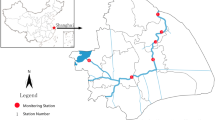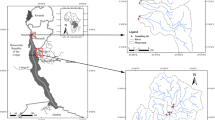Abstract
In this study, we proposed a dynamic complex hypothesis that the impact of land use on water quality could vary along the expansion of the buffer size, and there should be an effective buffer zone where the strongest linkage occurs between land use and water quality. The hypothesis was tested and supported by a case study carried out in four watersheds in Hanyang District, China. More specific, buffer analysis and regression model were applied for studying the impacts of land use type, area proportion of land use type, and spatial pattern of land use on water quality. We conclude that not only the proportion of land use but also the spatial pattern moderates the impact of land use on water quality. Our study indicates that the identification of the effective buffer zones can provide new information and ideas for planning and management. Moreover, this study could also partially help to explain the conflicting results on the impact of land use on water quality in buffer versus in catchments in the literatures.
Similar content being viewed by others
References
Alberti M, Booth D, Hill K, Coburn B, Avolio C, Coe S, Spirandelli D (2007) The impact of urban patterns on aquatic ecosystems: an empirical analysis in Puget lowland sub-basins. Landscape Urban Plan 80(4):345–361
Amiri BJ, Nakane K (2009) Modeling the linkage between river water quality and landscape metrics in the Chugoku District of Japan. Water Resour Manag 23(5):931–956
Bannerman RT, Owens DW, Dodds RB, Hornewer NJ (1993) Sources of pollutants in Wisconsin stormwater. Water Sci Technol 28(3–5):241–259
Basnyat P, Teeter LD, Lockaby BG (1999) Relationships between landscape characteristics and nonpoint source pollution inputs to coastal estuaries. Environ Manage 23(4):539–549
Basnyat P, Teeter LD, Lockaby BG, Flynn KM (2000) The use of remote sensing and GIS in watershed level analyses of non-point source pollution problems. Forest Ecol Manag 128:65–73
Brezonik PL, Stadelmann TH (2002) Analysis and predictive models of stormwater runoff volumes, loads, and pollutant concentrations from watersheds in the Twin Cities metropolitan area, Minnesota, USA. Water Res 36(7):1743–1757
Cao WZ, Bowden WB, Davie T, Fenemor A (2009) Modelling impacts of land cover change on critical water resources in the Motueka river catchment, New Zealand. Water Resour Manag 23(1):137–151
Chang HJ (2008) Spatial analysis of water quality trends in the Han River basin, South Korea. Water Res 42:3285–3304
Changnon SA, Demissie M (1996) Detection of changes in streamflow and floods resulting from climate fluctuations and land-use drainage changes. Climatic Change 32:411–421
Conway TM, Lathrop RG (2005) Alternative land-use regulations and environmental impacts: assessing future land-use in an urbanizing watershed. Landscape Urban Plan 71:1–15
Donohue I, McGarrigle ML, Mills P (2006) Linking catchment characteristics and water chemistry with the ecological status of Irish rivers. Water Res 40(1):91–98
EPA China (2002) GB3838-2002. Available on: http://www.sepa.gov.cn/image20010518/3391.pdf (in Chinese, accessed 15 Aug 2008)
ESRI (2001) ArcGIS 8.1. Environmental Systems Research Institute Inc., Redlands, California
Fang JY, Rao S, Zhao SQ (2005) Human-induced long-term changes in the lakes of the Jianghan Plain, Central Yangtze. Front Ecol Environ 3(4):186–192
Foley JA, Ruth D, Asner GP et al (2005) Global consequences of land use. Science 309:570–574
Gburek WJ, Folmar GJ (1999) Flow and chemical contributions to streamflow in an upland watershed: a baseflow survey. J Hydrol 217:1–18
Gillies RR, Box JB, Symanzik J, Rodemaker EJ (2003) Effects of urbanization on the aquatic fauna of the Line Creek watershed, Atlanta—a satellite perspective. Remote Sens Environ 86:411–422
Grassland, Soil & Water Research Laboratory (2001). Soil & Water Assessment Tool. Available on: http://www.brc.tamus.edu/swat/soft_model_2000soft.html (accessed 20 May 2009)
Grimm NB, Faeth SH, Golubiewski NE, Redman CL, Wu JG, Bai XM, Briggs JM (2008) Global change and the ecology of cities. Science 319:756–760
Gustafson EJ (1998) Quantifying landscape spatial pattern: what is the state of the art? Ecosystems 1:143–156
Ha HJ, Stenstrom MK (2003) Identification of land use with water quality data in stormwater using a neural network. Water Res 37(17):4222–4230
Hanratty MP, Stefan HG (1998) Simulating climate change effects in a Minnesota agricultural watershed. J Environ Qual 27:1524–1532
Hunsaker CT, Levine DA (1995) Hierarchical approaches to the study of water quality in rivers. BioScience 45:193–202
Johnson LB, Richards C, Host GE, Arthur JW (1997) Landscape influences on water chemistry in Midwestern stream ecosystems. Freshwater Biol 37:193–208
Kim G, Choi E, Lee D (2005) Diffuse and point pollution impacts on the pathogen indicator organism level in the Geum River, Korea. Sci Total Environ 350:94–105
Leitch C, Harbor J (1999) Impacts of land-use change on freshwater runoff into the near-coastal zone, Holetown Catchments, Barbados: comparisons of long-term to single-storm effects. J Soil Water Conserv 3:584–592
Liu Y, Yu YJ, Guo HC, Yang PJ (2009) Optimal land-use management for surface source water protection under uncertainty: a case study of Songhuaba Watershed (Southwestern China). Water Resour Manag 23(10):2069–2083
Mander U, Kull A, Tamm V, Kuusemets V, Karjus R (1998) Impact of climatic fluctuations and land use change on runoff and nutrient losses in rural landscape. Landscape Urban Plan 41:229–238
Mattikalli NM, Richards KS (1996) Estimation of surface water quality changes in response to land-use change: application of the export coefficient model using remote sensing and geographical information system. J Environ Manage 48:263–282
McGarigal K, Marks BJ (1995) FRAGSTATS: spatial pattern analysis program for quantifying landscape structure. Forest Science Department, Oregon State University, Corvallis
Mehaffey MH, Nash MS, Wade TG et al (2005) Linking land cover and water quality in New York City’s water supply watersheds. Environ Monit Assess 107:29–44
Moreno JL, Navarro C, De Las Heras J (2006) Abiotic ecotypes in south-central Spanish rivers: reference conditions and pollution. Environ Pollut 143:388–396
O’Neill RV, Hunsaker CT, Jones KB, Riitters KH, Wickham JD, Schwartz PM, Goodman IA, Jackson BL, Baillargeon WS (1997) Monitoring environmental quality at the landscape scale. BioScience 47(8):513–519
Palmer M, Bernhardt E, Chornesky E et al (2004) Ecology for a crowded planet. Science 304:1251–1252
Phillips JD (1989) Evaluation of North Carolina’s estuarine shoreline area of environmental concern from a water quality perspective. Coastal Manage 17:103–117
Rai SE, Sharma E (1998) Comparative assessment of runoff characteristics under different land-use patterns within a Himalayan watershed. Hydrol Process 12:2235–2248
Ren WW, Zhong Y, Meligrana J, Anderson B, Watt WE, Chen JK, Leung HL (2003) Urbanization, land use, and water quality in Shanghai 1947–1996. Environ Int 29(5):649–659
Sawyer JA, Stewart PM, Mullen MM, Simon TP, Bennett HH (2004) Influence of habitat, water quality, and land use on macro-invertebrate and fish assemblages of a southeastern coastal plain watershed, USA. Aquat Ecosyst Health 7(1):85–99
Sieker H, Klein M (1998) Best management practices for stormwater runoff with alternative methods in a large urban catchment in Berlin, Germany. Water Sci Technol 38(10):91–97
Shao M, Tang XY, Zhang YH, Li WJ (2006) City clusters in China: air and surface water pollution. Front Ecol Environ 4(7):353–361
Sliva L, Williams DD (2001) Buffer zone versus whole catchment approaches to studying land-use impact on river water quality. Water Res 35(14):3462–3472
Sonzogni WC (1980) Pollution from land runoff. Environ Sci Technol 14(2):148–153
Tang Z, Engel BA, Pijanowski BC, Lim KJ (2005) Forecasting land use change and its environmental impact at a watershed scale. J Environ Manage 76(1):35–45
Tomer MD, as Principal Investigator (2002) Optimizing the placement of practices that improve water quality within a watershed. Research Project 01-024—Final Report. USDA/ARS–National Soil Tilth Laboratory
Tong STY, Chen WL (2002) Modeling the relationship between land-use and surface water quality. J Environ Manage 66:377–393
Tsihrintzis VA, Hamid R (1998) Runoff quality prediction from small urban catchments using SWMM. Hydrol Process 12:311–329
Van Dessel W, Van Rompaey A, Poelmans L, Szilassi P (2008) Predicting land cover changes and their impact on the sediment influx in the Lake Balaton catchment. Landscape Ecol 23(6):645–656
Wang X (2001) Integrating water-quality management and land-use planning in a watershed context. J Environ Manage 61:25–36
Wiens JA (2002) Riverine landscapes: taking landscape ecology into the water. Freshwater Biol 47(4):501–515
Author information
Authors and Affiliations
Corresponding author
Rights and permissions
About this article
Cite this article
Guo, Q., Ma, K., Yang, L. et al. Testing a Dynamic Complex Hypothesis in the Analysis of Land Use Impact on Lake Water Quality. Water Resour Manage 24, 1313–1332 (2010). https://doi.org/10.1007/s11269-009-9498-y
Received:
Accepted:
Published:
Issue Date:
DOI: https://doi.org/10.1007/s11269-009-9498-y




